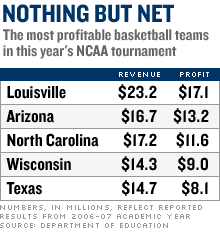 |
Commentary: | |
| SportsBiz | ||
Big dollars score in NCAA tourney
Upsets are fun to see but the fact is that small-budget Cinderellas have little chance against deep-pocketed schools in March Madness.

 |
| Duke got a scare from upstart Belmont in this year's NCAA tournament, but the big dollar teams typically win out in the end. |

NEW YORK (CNNMoney.com) -- You might think that Mount St. Mary's doesn't belong on the same basketball court with North Carolina in Friday night's NCAA match-up. But the small school from rural Maryland is a lot closer to the Tar Heels in talent than they are in earning power off the court.
According to figures filed with the Department of Education by each school, North Carolina's men's basketball program had revenue of $17.2 million during the 2006-07 school year, second only to the University of Louisville's $23.2 million among the 65 in this year's tournament. North Carolina's profit of $11.6 million is behind only Louisville's and Arizona's.
By comparison, the Mount, as it is known to its students and faculty, essentially broke even with revenue of $876,744 from it's men's basketball program. That makes it the tenth poorest school invited to March Madness this year.
Mississippi Valley State, with revenue of $233,036 had the lowest revenue from its men's program. It also lost $249,199 from its men's basketball program, is the poorest. (Add your own joke about Mississippi Valley scoring only 29 points vs. UCLA here).
I've got a particular rooting interest in Friday's North Carolina-Mount-mismatch since my sister-in-law, Mary Kate Birge, is a nun and a professor at Mount St. Mary's. She'll be risking a trip to confession in order to watch her school on Good Friday, and unfortunately probably using words she's not supposed to use on any day of the year.
Since the Mount is a Catholic school, she won't be the only one bending the rules to watch the game -- and praying for a chance to watch the team play in the second round on Easter.
History and any objective judging of talent says the Mount has no chance to beat North Carolina. No 16th seeded team ever has knocked off a No. 1 seed. Just to tilt the field a bit more towards the Tar Heels' favor, the game is being played a little ways down the road from Chapel Hill in Raleigh, NC.
But every year people watch these mismatches in the hopes they'll be surprised. There have been a handful of 15 seeds who knocked off 2 seeds in the first round. And tiny Belmont (revenue of $1.2 million) almost did so against mighty Duke (revenue of $13.4 million) Thursday night.
Duke and North Carolina, besides sharing a one of the great rivalries in sports, also share a built-in financial advantage.
The poor schools will stay poor despite the $545 million per year that CBS (CBS, Fortune 500) is paying to broadcast the tournament during the life of its current 11-year deal. The television and ticket money is mostly paid to the conferences, based upon the games in the tournament played by each conference over the the most recent six years. Those pools of money are then split between the teams in the conferences.
So even if Duke and North Carolina had both lost their first games this year and Belmont and Mount St. Mary had somehow both made it to the final game of the tournament, the bigger checks from the 2008 NCAA would have gone to ACC-members Duke and North Carolina, not the upstarts.
In addition, the regular-season ticket sales and television money for the powerhouses from the major conferences dwarf what's available for the so-called mid-major schools.
There are a few mid-major schools in the tournament with large revenue streams and good prospects, like Memphis and Xavier, but they're the exception, not the rule.
The 34 schools from the major conferences in this year's tournament have average revenue of $9.4 million, and an average profit of $4.4 million, giving them a 47% profit margin that any NBA team would give up a decade worth of No. 1 draft picks to achieve.
The remaining schools from the so-called "mid-major" conferences average just under $2 million in sales and an an average profit of $360,814, giving them a profit margin of only 18%. In fact, eight of those 31 schools reported losses from their basketball programs.
So by the time the Final Four arrives in two weeks, it is most likely to come down to the big money, top-seeded teams playing each other, as it does almost every year.
And while everyone says they love the David vs Goliath battles of the NCAA, the ratings for the Final Four show that what America truly loves is when big schools make it to the finals.
More people watched the final three games of the tournament, which included Florida, Ohio State, Georgetown and UCLA, than watched the four-game sweep of small market Cleveland by even smaller market San Antonio in last year's NBA Finals.
It's likely the Mount and Belmont will be distant memories when the final game is played April 7. And that will be just fine for CBS, most basketball fans and the teams that profit from the tournament. ![]()

